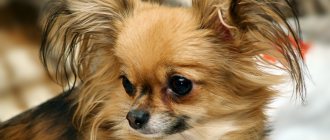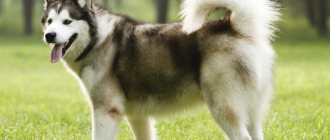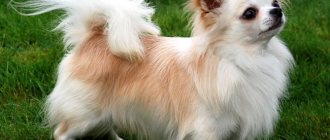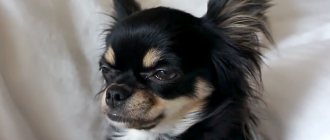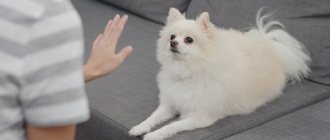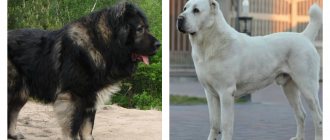Among the Chihuahua colors, blue is considered one of the rarest and most beautiful.
Dogs of this color look very unusual and original.
The blue color of a Chihuahua can be either dark graphite or light, smoky.
What else is remarkable about blue Chihuahuas and what do those who dream of such a pet need to know about them?
In this article we will try to answer these questions and also show a photo of a blue Chihuahua.
Origin story
Already in ancient times, blue color was characteristic of dogs of some breeds, including representatives of the Techichi breed. These small, squat dogs date back to the 15th century BC. bred in what is now Mexico. It was these animals that became the ancestors of the Chihuahua, which, having gone wild after the Spanish conquest in the 16th century, were then re-domesticated by local residents.
There were probably blue Chihuahuas among the puppies that Mexican traders sold to American travelers in the mid-19th century, who later became the first breeders of the modern type of this breed.
Read more about the history of the Chihuahua here.
NOTE!
In 1923, when the first Chihuahua breed club appeared and the first breed standard was written, all colors, including blue, were already considered standard.
The mystery of the origin of merle color
For Chihuahuas, the breed standard allows for any colors and shades of fur. The exception is merle. Interest in the variegated color is fueled by the fact that over the course of 3000 years of evolution, the specimen did not show itself in any way.
The first merle-colored Chihuahua puppies were obtained in the USA in the mid-90s. The variegated color of the coat gave the breed an unusual appearance, and therefore attracted the attention of dog lovers.
Against the backdrop of increased demand, nurseries have adjusted to consumer tastes. A couple of years later, marbled Chihuahuas entered Europe, and then into Russia. They even took prizes at specialty shows.
Today Avito is full of advertisements for the sale of Chihuahua puppies with merle color. The cost of “exotic” pets is unreasonably high. I do not recommend buying such puppies. I'll explain why below.
The marbled coloring is not an independent color, but is superimposed on top of the dog’s original coat pattern. It has a mottled texture with a pronounced lightening effect. May affect skin and iris pigmentation.
Marriage or breed?
The blue color is not considered a fault of the breed, since other than merle, Chihuahuas do not have non-standard colors.
Expert opinion
Tolkachev Andrey Mikhailovich
veterinarian
A blue Chihuahua looks very impressive, but it is not always possible to get healthy puppies of this color. The birth of silver or graphite gray puppies, which may have health problems in the future, is the result of an ill-conceived approach to breeding. People who want to adopt a dog of this color need to remember that one of the parents of the puppy they choose must be any color other than blue. In this case, the pet will not have a tendency to allergies or baldness. But even in this case, the blue Chihuahua will require a little more attention from the new owner to the conditions of its maintenance and diet.
From the history
This dog breed has very ancient roots. Nowadays it is considered decorative, but at one time its representatives performed security functions. And although, looking at such little ones, it’s hard to believe, those who know these doggies better can confirm that they are very brave.
This character trait was often used by persons of royal blood from Japan and China in ancient times, hiding little brave men in their sleeves and other secluded places of clothing. And if someone made an attempt on their lives, the emperors gave free rein to their pocket dogs, which made a huge noise, which not only attracted the attention of the rulers’ guards, but could actually frighten nervous attackers.
These are the heroes the ancestors of those very purple Chihuahuas, whose photos are shown here, were known for. Images of similar dogs are also found among the ancient Aztecs and Mayans. Breeders of the Middle Ages made a very big contribution to the development of the breed.
Advantages and disadvantages
Pros:
- the blue color looks very unusual and impressive;
- sociable and sociable dogs;
- selflessly devoted to their masters;
- without hesitation they will rush to protect the owner in case of danger;
- can live even in a very small apartment;
- if necessary, they will scare away the thief by barking;
- they do not need to be taken outside in the rain or cold, as a diaper or tray is enough for them;
- their coat is easy to care for;
- love to travel with their owners;
- They are easy to train if trained in the form of a game.
Minuses:
- not recommended for families with small children;
- these dogs get injured;
- the fontanel may not heal;
- if raised incorrectly, they become evil;
- tend to choose only one owner in the family;
- their training requires a special approach;
- are cocky and can attack other dogs;
- jealous;
- They do not get along well with dogs that are not their own breed.
IMPORTANT!
Blue Chihuahuas are prone to allergies, which is why you need to carefully monitor their diet.
Dimensions, weight and other features
The height at the withers of standard Chihuahuas does not exceed 23 cm. Weight varies from 0.5 to 3 kg.
The Blue Chihuahua is a small, graceful and well-proportioned dog with a preferably square body shape.
The head is convex, with a pronounced transition from the forehead to the muzzle, tapering towards the nose.
The ears are quite large, triangular, and widely spaced.
The eyes are round, rather convex, but not bulging. The most preferred eye color is dark brown.
The nose is usually blue, matching the base color.
The neck is elongated, with a graceful, but not too pronounced bend. The back is straight, the croup is slightly sloping.
The chest is quite deep, wide and voluminous, usually reaching the elbows.
The front paws should be level and parallel. The hind legs, slightly longer than the front legs, should also appear parallel when viewed from behind.
The tail is not docked. Medium length and set quite high.
The color can be any of the grayish-blue shades - from silver to dark slate.
Dogs whose coat has a medium-light blue color look the most elegant; besides, dark-colored puppies may subsequently have problems with their skin and coat.
What are the varieties?
Smooth-haired
Smooth-haired blue Chihuahuas look like silver figurines - they are graceful and very graceful. The coat of such dogs is very short, soft and close-fitting.
Shorthair
These dogs have longer hair than smooth dogs. She may even puff up a little. The hairs are soft, not too short, and may lie tightly or slightly bristle.
Longhair
The coat is long, but not excessively long. The fur is soft, straight or slightly wavy. Blue long-haired Chihuahuas have feathers on their ears, neck and paws.
NOTE!
According to the standard, only smooth-haired and long-haired coat types are considered acceptable for Chihuahuas.
Mini
The weight of a blue mini Chihuahua is from 1 to 1.5 kg. These dogs are a little more fragile and delicate than standard dogs.
Micro
These dogs are very tiny - they weigh from 0.5 to 1 kg. Blue micro Chihuahuas require especially careful handling, and it is also necessary to carefully monitor their health.
Cobby
Stocky dogs with well-developed muscles and a rounded head with widely spaced protruding eyes, not too large, low-set ears and a short muzzle.
Dir
The Deer type Chihuahua does not have pronounced muscles. They look slimmer and longer-legged than the cobby type.
Chihuahua colors: all possible options (+ photos)
Many nurseries in Europe and the USA are engaged in breeding Chihuahuas. A large number of puppies for sale gives rise to serious competition. Breeders, who are also sellers, keep up with the pace of the market and show marketing skills, and most often it is the colors of Chihuahuas that are framed as “trump cards”. If you go to any marketplace and look through the offers, every second ad will indicate - unique, chic, rare, unforgettable, etc. color
Let's start with the basics, that is, with theory - the official FCI (Federation Cynologique Internationale) standard allows any color of Chihuahua, except (!) Merel. The restriction is explained by concern for the health of the breed lines. Incomplete coloring of hairs is, roughly speaking, a gene mutation, that is, an exotic color can result in serious problems with vision and hearing. The abundance of puppies with color defects is justified only by the demand of inexperienced owners. People are chasing illusory beauty, the market adapts to the demands of buyers and...potentially unhealthy puppies become expensive goods with a rare color.
Note! Color is a concept that combines the color of fur, eyes, skin, nose and claws.
Naturally, nurseries do not have complete freedom of action and some limits exist. The genetics of Chihuahua colors suggests a list of preferred colors and so-called markings. Markings mean a color scheme that is the same for all colors:
- Pure color - allows white spots on the chest and toes.
- Pure color with white markings is a similar option, but the spots are larger and can be located on the head, chest, paws and tail (most often at the tip).
- White color with spots - when white hair covers more than 80% of the dog's body area.
- Tricolor – a color of three colors, the main one is white, covering more than 50% of the dog’s body area.
Next, we will consider the Chihuahua color groups from the point of view of activation. That is, from the point of view of certain characteristics by which puppies are “assigned” one color or another.
White is a pure coat color without spots, speckles or marks, the skin is pink, the nose and claws are black or brown.
Black – pure color without specks or inclusions on the body, small white markings on the chest or fingers are acceptable, the nose and claws are black.
- White and black (white with black markings) - the body is painted black, there are clear white spots on the chest and paws, small markings on the muzzle and tail.
- Black and white – the main color is white, the black spots are large, contrasting, clean, located on the head and body.
Life expectancy and health
Standard blue Chihuahuas live 12-15 years. The lifespan of mini and micro varieties does not exceed 10 years.
Chihuahuas may be predisposed to the following diseases :
- demodicosis;
- dislocated kneecaps;
- cataract;
- respiratory diseases;
- urolithiasis disease;
- hypoglycemia;
- hydrocephalus;
- diseases of the teeth and oral cavity.
Blue dogs are also prone to allergies, hair loss and dermatitis, and they may have a weaker immune system than Chihuahuas of other colors.
Blue Chihuahuas need to strictly follow and deworming schedule
Does a puppy's color change as it ages?
Blue Chihuahua puppies can turn blue-fawn, almost black and even red.
Dogs that have blue noses, paw pads and eyelids will either remain bluish-gray or change to blue-fawn.
Puppies with black pigmentation on the nose, paws and eyelids often fade to a reddish color.
Rules of care
Caring for smooth-haired and short-haired blue dogs consists of systematic (2-3 times a week) brushing. Long-haired Chihuahuas need to be combed daily.
It is not necessary to wash dogs often, and it is better not to do it at all unless necessary, as blue Chihuahuas can be sensitive to grooming products such as shampoos and conditioners.
You should periodically examine your pet's ears, but clean them only if they are dirty. Eyes also need to be cleaned as they become dirty or sour.
Chihuahuas' claws are trimmed once every two weeks using a guillotine nail clipper.
teeth
are cleaned with the help of special toys or treats that are given to the pet to chew on.
CAREFULLY!
If tartar forms, you should not try to remove it yourself. You need to take your pet to the clinic, where the veterinarian can easily and painlessly rid him of hardened plaque.
Like all other small breeds, blue Chihuahuas need to be covered in rain or cold weather.
Male Pinky, long-haired Chihuahua, USA, lilac color with blue eyes.
Meet! This one is my Pinky! This is his personal page and this is where he lives!
Date of birth October 20, 2012 Pedigree name STRONG STYLE IMPRESS PINK FAVORITE, long-haired chihuahua, lilac color with blue eyes, owner Titova Y. Home name PINKY (PINKFLOYD). Pinky - Small standard, closed spring, scissor bite, canines are symmetrically correct, passes on scissor bite to offspring, even teeth 6x6.
V I D E O with the participation of Pinky: At 5 months at the Eurasia-1-2013 exhibition, Pinky became the Winner of the “Autumn Walk 2013.” Best Breed Baby Longhaired Chihuahua
Anya and Pinky are fashionable, autumn 2013. Autumn leaves, 2013
Autumn 2015 February 2016
https://youtu.be/j2xjuOrJ20Mhttps
://youtu.be/EWs83MtfKts
https://youtu.be/iv5VwbT1hg0https
://youtu.be/q6Q5fKqar1Y
https://youtu.be/SbWoCHbmtdYhttps
://youtu.be/ t3AcWorusCY
https://youtu.be/b-xgO_gwYjUhttps
://youtu.be/ahUA6V_T1vs
- Exhibitions
- Offspring, Pinky's children
- Pedigree
| Pinky 2 months | Color lilac with blue eyes |
| 3 months |
| At the dog show on February 23, 2013. Pinky at 3 months 3 weeks took 4th place in best baby | Pinky winner of Eurasia 2013, best baby longhaired chihuahua |
| Pinky and Briton Richie are visiting. In the photo Pinky is 6 months old. | Pinkfloyd at Briton Richie's birthday party. Pinky 6 months. |
| Pinky is one year old | Pinky has grown up a little |
| October 2013 | |
| Let's train our stance! | |
| Fawn and lilac longhaired chihuahua | Dog Show Awards |
| Lilac long-haired chihuahua owned by Titova Ya.Yu. | Year and 5 months |
| April 2014 | Saying goodbye to winter 2014 |
| Bright spring sun | Pinky with her friend Eclair |
| Breakfast in the fresh air. The menu includes rabbit with potatoes. | Walk along the spring beach |
| Pinky saw ducks on the water in the bay, chased them and swam in the icy water. But he returned... | At the “Professional” 2014 exhibition my Pinky received the rating “Excellent 1”, CAC, class winner from the expert from England Geoffrey Curr |
| Description of the English expert Geoffrey Curr: Very pleasant, compact, well built, correct tail set, correct skull, N bite, nice ears, correct coat, good light body. | April 13, 2014 lilac long-haired chihuahua Pinky won BOB and 3rd place in Best of the 9th group, judge Chistyakova L. Description: very thoroughbred, excellent type, correct size, very nice head, good pigment, good set of ears, correct coat structure, correct movements. |
| Purple Dutch tulips | |
| Pinky one and a half years old | |
| Evening walk at home | My dog Pinky - "Pink" in English means pink. Pink nose, pink fur. |
| Walk before bed | |
| Blooming lilac | My purple dog. May 2014 |
| Pinky is one and a half years old | |
| Pinky loves looking at ducks. One day he broke free and ran after them, and threw himself into the icy water and swam. But the little devil is back! | |
| We train hard | Who can make a better rack? |
1 Ctrl →
Copyright. Palmer Nursery - Palmer
How to choose a puppy?
Due to the fact that mating two blue dogs can produce sickly offspring, and tracing the origin of puppies without documents can be problematic, such a pet should only be purchased from a kennel or from a responsible breeder.
When choosing a baby, you need to pay attention to his health, behavior and appearance.
A healthy Chihuahua puppy shows no signs of illness. He does not hide in a corner when strangers appear, but approaches them and at the same time does not show aggression, but benevolent curiosity.
NOTE!
In order to be sure that the puppy will definitely not turn fawn or red, you need to look at the pigmentation color of his nose, eyelids and paw pads. In true blue dogs (as well as in those who change color to fawn blue), it will be in tone with the main color, since there is no black pigment in the body of these dogs.
How is it inherited?
It is assumed that dogs with such a unique color once developed some kind of special gene that helped lighten the shade of their coat. Moreover, it was not dominant, but recessive. This means that the color of interest can be inherited only if both the mother and father of the future lilac Chihuahua puppy are owners of the specified gene. This does not mean that they themselves must have that particular coat color. It’s just that their relatives must have ancestors of a similar color, who passed on to them a certain genetic set.
Selecting suitable partners for mating in order to obtain the desired color from the offspring is not so difficult. It is enough to study the pedigree of the applicants, because all the colors of their predecessors are indicated there.



